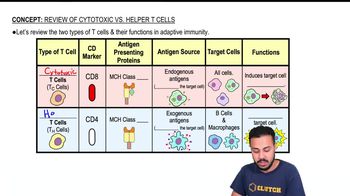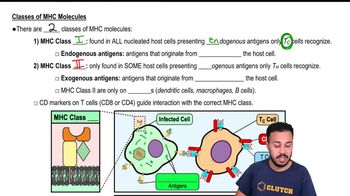Match the following choices to the statements in questions 5–7:
a. IgA
b. IgD
c. IgE
d. IgG
e. IgM
Antibodies that are bound to mast cells and involved in allergic reactions.
 Tortora 14th Edition
Tortora 14th Edition Ch. 17 - Adaptive Immunity: Specific Defenses of the Host
Ch. 17 - Adaptive Immunity: Specific Defenses of the Host Problem 17.9a
Problem 17.9a Verified step by step guidance
Verified step by step guidance



Match the following choices to the statements in questions 5–7:
a. IgA
b. IgD
c. IgE
d. IgG
e. IgM
Antibodies that are bound to mast cells and involved in allergic reactions.
Explain why a person who recovers from a disease can attend others with the disease without fear of contracting it.
Put the following in the correct sequence to elicit an antibody response: (1) TH cell produces cytokines; (2) B cell contacts antigen; (3) antigen fragment goes to surface of the B cell; (4) TH recognizes antigen fragment and MHC; (5) B cell proliferates.
a. 1, 2, 3, 4, 5
b. 5, 4, 3, 2, 1
c. 3, 4, 5, 1, 2
d. 2, 3, 4, 1, 5
e. 4, 5, 3, 1, 2
NAME IT A purified protein from Mycobacterium tuberculosis is injected into a person’s skin. A hardened, red area develops around the injection site within 3 days.
Use the following choices to answer questions 1 and 2:
a. hemolysis
b. hemagglutination
c. hemagglutination inhibition
d. no hemolysis
e. precipitin ring forms
Patient’s serum, influenza virus, sheep red blood cells, and anti-sheep red blood cells are mixed in a tube. What happens if the patient has antibodies against influenza?
Use the following choices to answer questions 1 and 2:
a. hemolysis
b. hemagglutination
c. hemagglutination inhibition
d. no hemolysis
e. precipitin ring forms
Patient’s serum, Chlamydia, guinea pig complement, sheep red blood cells, and anti-sheep red blood cells are mixed in a tube. What happens if the patient has antibodies against Chlamydia?